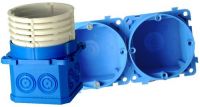Hello.
I need to drill one additional 230V socket in the side of the kitchen cabinet.
Due to the fact that I do not have too much space, I cannot install a surface-mounted socket (they protrude strongly from the wall of the cabinet) - so I will have to drill a hole in the cabinet and insert a normal socket there, just like in the wall (such as a flush-mounted box)
Does anyone know what are the names of the boxes that I can protect the installation from the inside of the cabinet - the idea is to cover the back wall of the socket where the wires enter.
I need to drill one additional 230V socket in the side of the kitchen cabinet.
Due to the fact that I do not have too much space, I cannot install a surface-mounted socket (they protrude strongly from the wall of the cabinet) - so I will have to drill a hole in the cabinet and insert a normal socket there, just like in the wall (such as a flush-mounted box)
Does anyone know what are the names of the boxes that I can protect the installation from the inside of the cabinet - the idea is to cover the back wall of the socket where the wires enter.



